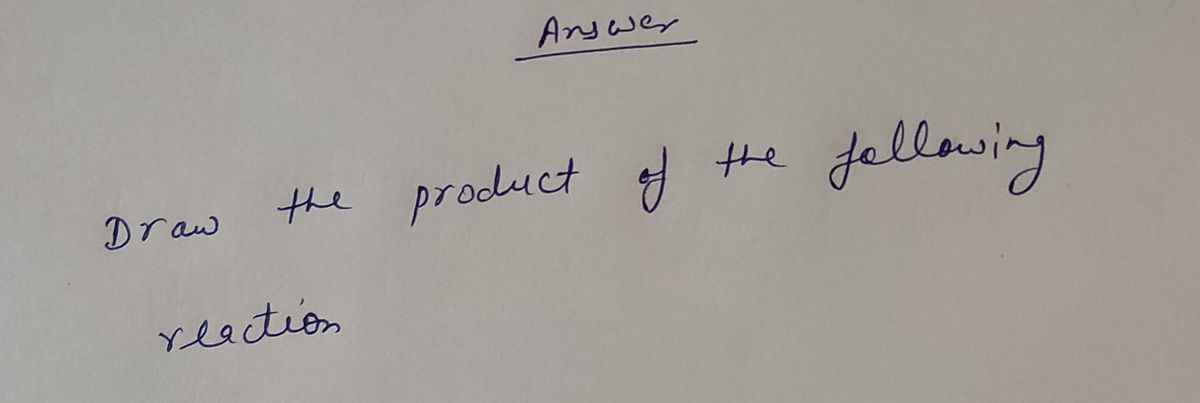Chemistry
10th Edition
ISBN:9781305957404
Author:Steven S. Zumdahl, Susan A. Zumdahl, Donald J. DeCoste
Publisher:Steven S. Zumdahl, Susan A. Zumdahl, Donald J. DeCoste
Chapter1: Chemical Foundations
Section: Chapter Questions
Problem 1RQ: Define and explain the differences between the following terms. a. law and theory b. theory and...
Related questions
Question
Draw the products of the following reactions

Transcribed Image Text:**Chemical Reaction A:**
- **Reactant:**
- A cyclohexene molecule with a methyl group (CH₃) and a hydrogen (H) attached.
- **Reagent:**
- Trimethylborane (H-B(CH₃)₂).
- **Product:**
- A cyclohexane molecule.
**Description:**
In this reaction, the double bond in cyclohexene reacts with trimethylborane, resulting in the conversion of the alkene to an alkane. The methyl group remains unchanged, and the double bond is reduced.
---
**Chemical Reaction B:**
- **Reactant:**
- A cyclohexene molecule with a simple hydrogen (H) structure.
- **Reagent:**
- Bromine (Br₂).
- **Product:**
- A cyclohexane molecule.
**Description:**
Here, the double bond in cyclohexene reacts with bromine, also leading to the formation of cyclohexane. The addition of bromine results in the removal of the double bond.
---
**Diagram Explanation:**
The diagram illustrates two reactions where cyclohexene undergoes transformations. In both cases, reagents interact with the double bond, converting it into a cyclohexane structure. This simplification results in saturation of the ring, achieving a stable cyclohexane product in each reaction.
Expert Solution
Step 1

Step by step
Solved in 3 steps with 3 images

Knowledge Booster
Learn more about
Need a deep-dive on the concept behind this application? Look no further. Learn more about this topic, chemistry and related others by exploring similar questions and additional content below.Recommended textbooks for you

Chemistry
Chemistry
ISBN:
9781305957404
Author:
Steven S. Zumdahl, Susan A. Zumdahl, Donald J. DeCoste
Publisher:
Cengage Learning

Chemistry
Chemistry
ISBN:
9781259911156
Author:
Raymond Chang Dr., Jason Overby Professor
Publisher:
McGraw-Hill Education

Principles of Instrumental Analysis
Chemistry
ISBN:
9781305577213
Author:
Douglas A. Skoog, F. James Holler, Stanley R. Crouch
Publisher:
Cengage Learning

Chemistry
Chemistry
ISBN:
9781305957404
Author:
Steven S. Zumdahl, Susan A. Zumdahl, Donald J. DeCoste
Publisher:
Cengage Learning

Chemistry
Chemistry
ISBN:
9781259911156
Author:
Raymond Chang Dr., Jason Overby Professor
Publisher:
McGraw-Hill Education

Principles of Instrumental Analysis
Chemistry
ISBN:
9781305577213
Author:
Douglas A. Skoog, F. James Holler, Stanley R. Crouch
Publisher:
Cengage Learning

Organic Chemistry
Chemistry
ISBN:
9780078021558
Author:
Janice Gorzynski Smith Dr.
Publisher:
McGraw-Hill Education

Chemistry: Principles and Reactions
Chemistry
ISBN:
9781305079373
Author:
William L. Masterton, Cecile N. Hurley
Publisher:
Cengage Learning

Elementary Principles of Chemical Processes, Bind…
Chemistry
ISBN:
9781118431221
Author:
Richard M. Felder, Ronald W. Rousseau, Lisa G. Bullard
Publisher:
WILEY